Thought Leadership Studio Podcast Episodes:
How to See the Invisible Structure of Thought Leadership
Episode 46 - Levels of story-telling beyond the basic structures, accelerated learning, high-level influence, and the power of myth
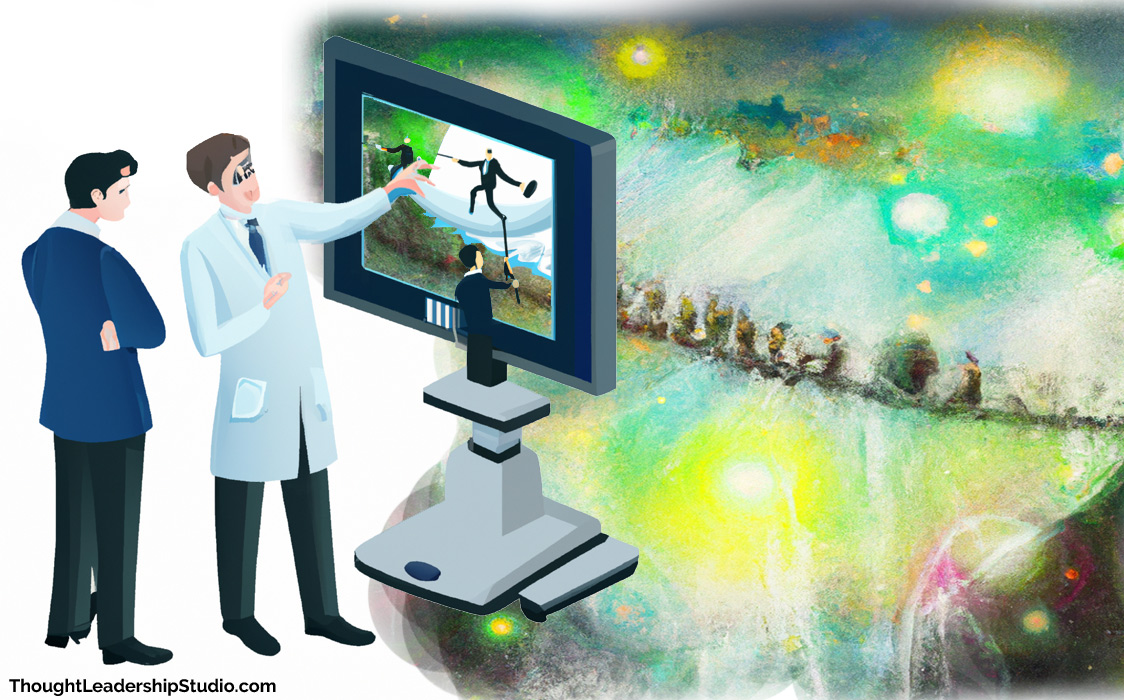
#archetypes, #coaching, #communication, #consulting, #contentwriting, #creativity, #influence, #insight, #marketingstrategy, #massinfluence, #music, #myth, #neurolinguisticprogramming, #paradigms, #paradigmshifts, #persuasion, #storytelling, #strategicthoughtleadership, #systemsthinking, #thoughtleadership, #thoughtleadership, #thoughtleadershipmarketing, #thoughtleadershipmodel, #workshop
Or Click here to listen or subscribe on appWhat this episode will do for you
- Empower your marketing, PR, leadership, or influence with key skills of Strategic Thought Leadership that can help you gain attention, build a following and enrapture the audience with compelling story-telling that makes a difference.
- Illuminate the advantages of seeing the hidden structure behind effective influence.
- Inspire you with personal and metaphorical examples of finding and using hidden structures.
- Reveal how hidden structures are layered and new levels can unfurl new advantages.
- Teach on both conscious and unconscious levels with the power of story-telling, myth and metaphor.
Curated Transcript of Podcast Episode 46- Unveiling the Invisible Structure: The Journey to Thought Leadership.
The transcript is lightly edited for clarity and is a partial transcript (with some bonus content)- the full episode is on audio. Click here to listen.
Metaphorical X-Ray Glasses
Welcome to another thought-provoking episode of the Thought Leadership Studio, where we delve deep into the invisible structure behind thought leadership and content marketing.
I'm your host, Chris McNeil, Thought Leadership Marketing Coach and Consultant, and I am here now to help you see the invisible. Strategic Thought Leadership has a lot to do with seeing the invisible. It's like in any audience, in any business goal, in any business model, there's not just an invisible structure - there are multiple levels of invisible structures that people need to develop the eyes to see.
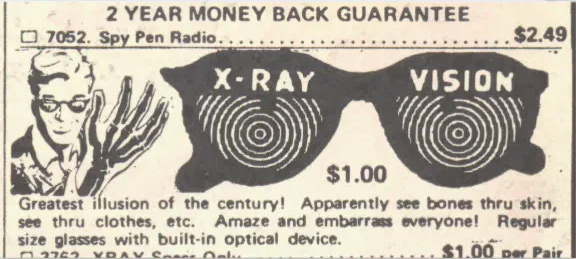 And isn't it curious how we humans are fascinated by seeing what was invisible? It was the (unmet) promise of the x-ray vision glasses I saw in ads in the comic books I read when I was a kid. "Greatest illusion of the century! Apparently see bones through skin, see thru clothes, etc. Amaze and embarrass everyone! Regular size glasses with built in optical device." And it was only $1.00 per Pair!
And isn't it curious how we humans are fascinated by seeing what was invisible? It was the (unmet) promise of the x-ray vision glasses I saw in ads in the comic books I read when I was a kid. "Greatest illusion of the century! Apparently see bones through skin, see thru clothes, etc. Amaze and embarrass everyone! Regular size glasses with built in optical device." And it was only $1.00 per Pair!
This episode is for those who communicate to positively persuade others. the listener might be a marketer, PR professional, or entrepreneur considering the strategy for a PR or marketing campaign. Maybe you are a social entrepreneur wondering how to orchestrate support for making positive social change. Maybe you're a professional or solopreneur crafting social media post and maybe feeling a little uncertain about whether these posts will resonate on a audience and - even if they get attention - the glitter doesn't translate to gold because people aren't moved to action.
Maybe you want to see a path from feeling tentative about a campaign, message, or marketing or PR direction to feeling confident it will both capture peoples' attention and engage them on a deep enough level to positively impact their thinking. It can be like going from wallowing in a sea of similar messages where people feel inundated with parrot content to standing out with confidence and leading people to new thinking that is well-packaged , captivating, and serves them on a higher level by helping them get more value out of what you sell or maybe more satisfaction out of creating deeper participating in a movement that is meaningful to you.
The Reticular Activating System (RAS) as Filter
So there's something called the reticular activating system that acts as a filter for conscious awareness. The reticular activating system is a complex network of nerve pathways located in the brainstem that filters attention - according to some estimates, letting through only 1-2% of available potential perceptions.
The RAS acts as a selective gatekeeper, prioritizing information based on our beliefs, values, interests, and goals. It helps us focus on what we consider relevant and important, while disregarding or filtering out most of what doesn't fit our preconceived models of the world.
It's a process of distortion, deletion, and generalization but this filtering process is essential for managing the overwhelming amount of sensory input we encounter daily and for maintaining a stable mindset.
So we're only receiving a really small percentage of the world around us and, if we consider that things on a quantum level exist on a level of vibration - only a narrow range of frequencies. Think about bats and dogs who can hear frequencies above that which humans can hear. Consider a polar bear who can smell a seal through 3 feet of ice.
There are vast worlds outside of our perceptions.
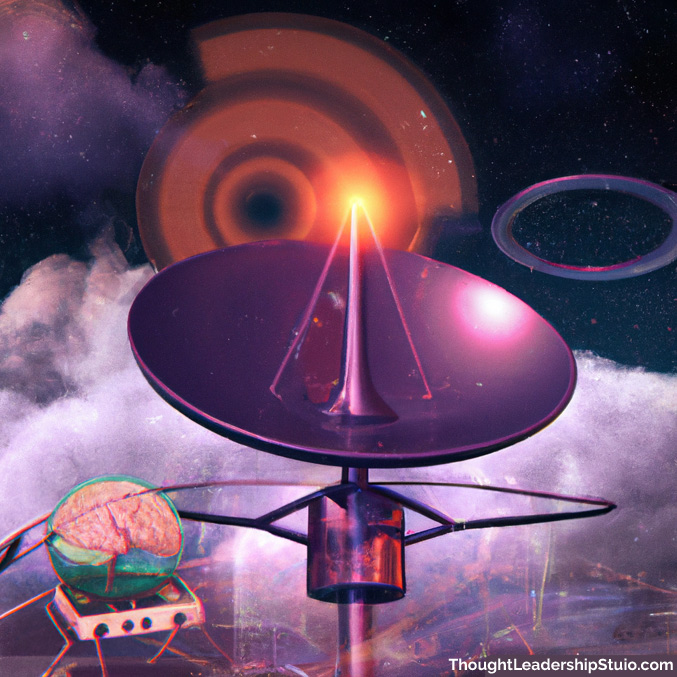 So we have this filtering function that filters out most of what's going on around us. What happens with the rest is we are subconsciously recording it, maybe so we can subconsciously access it from our intuitive functions.
So we have this filtering function that filters out most of what's going on around us. What happens with the rest is we are subconsciously recording it, maybe so we can subconsciously access it from our intuitive functions.
Consider how hypnosis has helped crime victims recover things like license plate numbers while in a trance. But for the purpose of this podcast, all I want you to consider is the incredible range of possible new perceptions we can have - possible new connections we can make and lead our audiences to... If our filters were more open to access more.
The might be a good point to mention the benefit of the listener to continually switch between any ideas that emerge from this and your current challenges, situations, and projects ... maybe like having a dual monitor desktop setup where you can use your mouse to drag things from one thing to another while you ask, "How does this apply in my life, my communication, my marketing, my project?"
If we suspend our habitual thinking patterns long enough to consider new patterns of thinking for ourselves and for our audiences, maybe it can help them get more value out whatever it is we're offering, whether that's a product or a service or a point of view of a philosophy, or a social movement's higher purpose.
You might consider it like switching the frequency of the radio dial that is connected to the reticular activating system. like switching channels, looking at things in a new frame. It can be using the "what if" frame. What if anything was possible and you are the master controller designing the virtual reality video game of life. How would you make things different?
 Then there's the frame of switching perceptual positions, an extremely useful frame in business. There's huge value in taking the customer viewpoint frame from which to design our businesses. This flows from the empowering belief system that it is the customer who determines the value of a service. And when you expand that out to consider all the media that we create as a service to customers who pay with attention ahead of paying with money, and realize that to maximize the value, whether that's getting more attention or making more sales or getting more attention in order to make more sales, it flows from the frame of maximizing the value from the customer's point of view.
Then there's the frame of switching perceptual positions, an extremely useful frame in business. There's huge value in taking the customer viewpoint frame from which to design our businesses. This flows from the empowering belief system that it is the customer who determines the value of a service. And when you expand that out to consider all the media that we create as a service to customers who pay with attention ahead of paying with money, and realize that to maximize the value, whether that's getting more attention or making more sales or getting more attention in order to make more sales, it flows from the frame of maximizing the value from the customer's point of view.
That customer viewpoint frame is a frame that's been used extremely effectively by my friend John Seddon's Vanguard method and with it they create breakthroughs in service businesses, simultaneously increasing profits and reducing costs.
Myth and Metaphor
Then there is metaphor, especially through telling well-structured metaphorical stories, as an extremely powerful way to work around the limited set of what the reticular activating system typically lets in.
Metaphorical stories structured with archetype patterns like the hero's journey have an impact on unconscious thinking as well as conscious thinking. They deeply engage the conscious mind with the front story of the particulars of the characters in the setting, while also activating powerful archetypes on the unconscious level through a back-story structure that evokes that which is often hard to put into words.
Hence the power of myth. Myth is not designed to be true in the sense of what we can see, hear, touch, taste and smell right in front of us. It's designed to convey higher truths that are beyond conscious thought with metaphor and analogies.
Mythological figures from this point of view might be taking a power of nature -something that's really hard to wrap the human mind around - and anthropomorphizing it by imagining this power of nature wrapped in the guise of a human-like figure that you can relate to and communicate with. And some can use this type of logical association to expand their belief systems to do things they previously didn't believe they could do.
It's like a technique of Psychodrama.
And that's really what we're trying to do with strategic thought leadership is expand people's belief systems so they get more out of whatever we're leading them to and have a more immersive experience of values that are that important to them as a result.
And that's the kind of hidden paths that are revealed in the first level of the unveiling.
This reveals the bridge from the baseline thinking of an audience that may be self-limiting - because they don't have your expertise - to the new thinking - the thought leadership position - that not only shares expertise, like increasing their skills and knowledge, but also expands their belief systems or even connects an audience's higher values that were not previously associated with it.
This is high level influence and accelerated learning.
Unveiling Levels of Hidden Structures in Music
I experienced two main levels of discovering and using hidden structures in music that opened up worlds for me. I had played guitar off and on as a hobby since I was a teenager but never got any lessons or musical training. I played with others, got a few books to learn some scales and considered myself a hobbyist. But I wanted more. Then I met a guitarist who had gone to Berkley School of music and was a trained classical and jazz guitarist.
He told me I could do a lot more if I learned music theory. But I was resistant, I had this belief system that once you start getting into music theory, you're not playing with "feel" anymore. And I like playing with feel and communicating emotion. So I had a block that made me resistant, but he needed my fitness company's help rehabilitating damaged muscles from over-practicing guitar and wanted to trade some lessons. So, I eventually gave in and learned what is called the modes of the major scale. I learned the basics of time signatures and, eventually, advanced scales and chord progressions. Surprisingly to me, it didn't take away from the "feeling" of music at all and instead was a breakthrough to new levels. I saw a logic I hadn't perceived before that made things fit together,
 That was the first level of unveiling hidden structures in music for me. And compared to where I was at before that, it was like a superpower. I had more confidence in knowing what chords fit together in a progression. If I was learning a song, what the most likely next chord to follow a certain chord was, and what notes that fit well playing a solo within the structure of a song. So I got much better and I was able to play with a higher level of other players.
That was the first level of unveiling hidden structures in music for me. And compared to where I was at before that, it was like a superpower. I had more confidence in knowing what chords fit together in a progression. If I was learning a song, what the most likely next chord to follow a certain chord was, and what notes that fit well playing a solo within the structure of a song. So I got much better and I was able to play with a higher level of other players.
But it wasn't until the next level of unveiling that was more unconventional that I felt the true hidden structure of music was revealed.
I had read a series of books called Strategies of Genius by Robert Dilts in which he used NLP methods to decode the thinking structures behind the great geniuses of history- people like Einstein, DaVinci, Walt Disney, and Aristotle. Mozart was one of the people he studied and he conveyed how Mozart was able to compose entire symphonies and retain them in his memory before writing the first note down. Mozart was able to do with by using an interesting series of synesthesias- translating one sense into another.
Mozart didn't just feel the music, he also tasted it like a meal and saw an entire musical piece all at once like a sculpture. He had a sequence of composing that passed the process from the conscious mind to the unconscious mind and from one sensory system to another as a music piece built up gradually from a few melodic ideas to an entire symphony. I practiced these mental skills, doing weird things like paying attention to the sounds around me and imagining they were all different kinds of food while thinking of what they would taste like.
After a while of this, despite having never written a note of original music in my life, songs just started pouring out of me.
Of course, Mozart also had a very quirky personality which you would know if you've seen the movie Amadeus. And movies bring up another point.
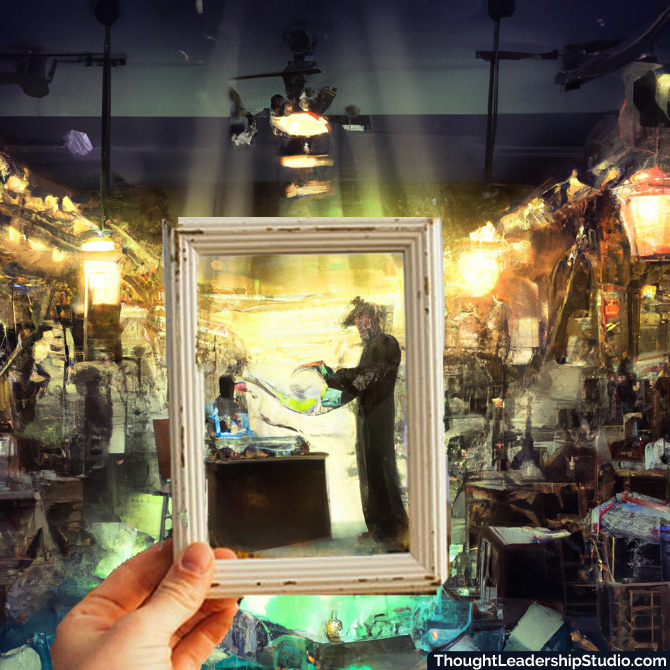 When we are watching a movie we see within the frame that the writer and director intended. If we opened up the frame - Monty Python style - we'd see the actors preparing with scripts, the director orchestrating events, set directors who create the illusion of a scene, and more "behind the scenes" trappings.
When we are watching a movie we see within the frame that the writer and director intended. If we opened up the frame - Monty Python style - we'd see the actors preparing with scripts, the director orchestrating events, set directors who create the illusion of a scene, and more "behind the scenes" trappings.
Imagine the set-building and screenplay writing behind the scenes as a hidden structure of a movie about a frog names Aiden.
Aiden the Adventure-Frog
In a realm of enchanting valleys and ancient forests, a group of curious adventurer-frogs, including the frog named Aiden, grew up captivated by the tales of a mystical bronze statue of a scorpion that held within it the power to unveil the secrets of an invisible bridge. Legends whispered of this ethereal bridge concealed deep within the enigmatic Valley of Mists, connecting their world to another realm abundant with a magical well. This enchanted well bestowed upon those who dared to cross the invisible bridge the gifts of regained health, longevity, and a life abundant with joy and prosperity.
Aiden and his frog friends had heard of the mysterious bronze scorpion from the elders of their frog village, but they doubted its existence. The stories seemed like mere fantasies, distant dreams that only belonged to the realm of legends. Yet, something deep within their frog hearts longed to believe in the possibility of such wonders.
One day, as the frog village went about their ordinary lives, a herald-frog appeared, carrying with him a radiant aura of enchantment. The herald-frog spoke of the hidden structures behind thought leadership and the magic that could be found in the unseen realms of the Valley of Mists. He spoke of the power of captivating narratives and the transformation they could bring to a frog's life.
The words of the herald-frog stirred something within Aiden and his adventurous frog mates, awakening a dormant yearning for knowledge and adventure. It was as if a veil had been lifted from their frog eyes, allowing them to see beyond the ordinary and glimpse the extraordinary.
Determined to seek the truth behind the mystical scorpion and the invisible bridge, Aiden and his friends embarked on their own heroic journey, guided by the memory of their parents' courage and the whispers of the scorpion's mystical powers.
In their quest, they found an unexpected ally in Eldara, a wise and mystical frog who had watched over them since they were tadpoles. Eldara sensed the purity in their frog hearts and chose to guide them in the ways of wisdom and compassion, knowing that the power of the scorpion could only be harnessed for the greater good.
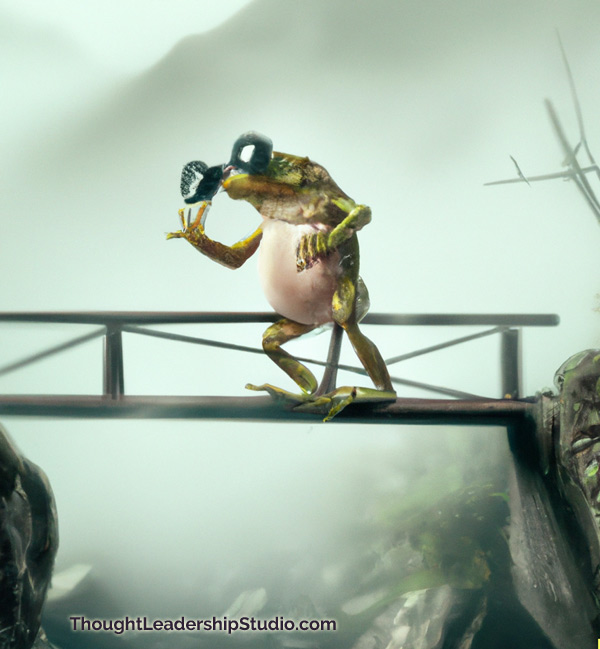 Together, the adventurous frog team ventured through treacherous forests and scaled towering lily pads, the veil of mist growing denser with every leap. But their determination and Eldara's guidance proved unyielding, and they pressed on through the enigmatic haze.
Together, the adventurous frog team ventured through treacherous forests and scaled towering lily pads, the veil of mist growing denser with every leap. But their determination and Eldara's guidance proved unyielding, and they pressed on through the enigmatic haze.
In their journey, they encountered numerous trials and faced morphic monsters that guarded the invisible bridge. These monsters had stolen the X-Ray vision goggles—the key to making the bridge visible—from the frog village long ago. Without the goggles, the bridge remained elusive, hidden from view.
Through courage and teamwork, Aiden and his frog friends managed to outwit the morphic monsters and recover the long-lost X-Ray vision goggles. As they donned the goggles, the invisible bridge materialized before their astonished eyes—a shimmering pathway connecting their world to the realm of wonders.
Filled with newfound excitement, they crossed the now-visible bridge, feeling an electrifying connection to the other realm—a realm of healing and abundance, where the scorpion's oracle could reveal the secrets of captivating storytelling.
Yet, to their astonishment, the bronze scorpion spoke to them, revealing that the true power of the invisible bridge lay not merely in the magical well, but in the wisdom and insight gained from the journey itself. The bridge symbolized an inner transformation—a bridge that led not only to physical healing but to a profound understanding of the hidden structures behind thought leadership.
Filled with joy and determination, Aiden and his frog friends returned to their village, not to hoard the scorpion's secrets for themselves, but to share the transformative power of their journey with their fellow frogs. They inspired others to embark on heroic quests of their own, encouraging them to seek not only the magic of the scorpion but the enchantment of self-discovery and the invisible bridge within.
The frog village became a beacon of hope and growth, as generations of adventurous frogs crossed the invisible bridge, not just to acquire the scorpion's powers, but to unlock the profound depths of their own frog hearts and minds. Aiden, now a wise mentor and guardian of the bridge, would guide others on their journeys, ensuring that the secret of the invisible bridge remained a testament to the transformative power of thought leadership and the timeless allure of captivating narratives.
The Invisible Bridge
The story of Aiden the Frog illustrate a basic first level of hidden structure behind Strategic Thought Leadership: a bridge from old thinking to new thinking. The appeal of the island the bridge leads to is made of the higher values of your audience. The support structures of the bridge are built of compelling talking points that undermine the old thinking and support the new thinking. That is the most basic level.
 Where are you leading people from? That might be also framed as "what problem do you solve". But people might not yet perceive a problem until you contrast their current state with what they could achieve, and what it means to them, with the new thinking of your Thought Leadership Position.
Where are you leading people from? That might be also framed as "what problem do you solve". But people might not yet perceive a problem until you contrast their current state with what they could achieve, and what it means to them, with the new thinking of your Thought Leadership Position.
Questions that start to reveal this structure are ones that illuminate hidden assumptions - like when an investor looks at a business plan that includes rosy projections and asks "what has to be true for this to happen?" If it is too much of a stretch, then that assumption might prove an impediment to funding. Unless the entrepreneur who is seeking funding understands the dynamics of Strategic Thought Leadership and has accounted for that with a clear path to building an audience around new thinking that benefits them.
And there are deeper and deeper levels of Thought Leadership Structure- way too much to get into in this podcast but I am providing a set of links for further study for the curious right here:
Resources for Further Study
***************************************
The transcript is lightly edited for clarity and is a partial transcript (with some bonus content)- the full episode is on audio. Click here to listen.
***************************************
Free Stuff and Offers Mentioned in Podcast
***************************************
***************************************